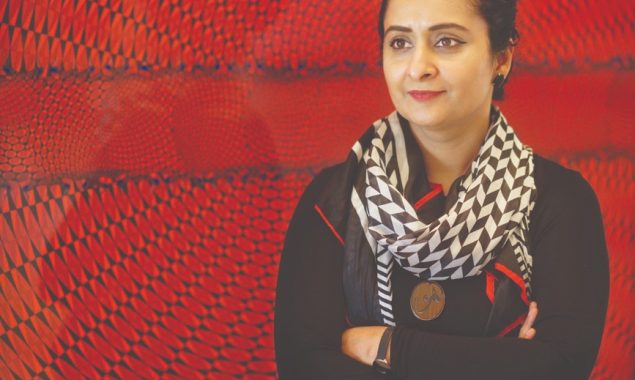
Aisha Khalid consistently treads the thin line between the conventionalities of her discipline and the wish to break away from them through contemporary practices
The Pakistani art world may be finite in its audience, but few artists bring as much of a public pull as Aisha Khalid and her work does. A pioneer in the neo-miniature movement, Khalid has effortlessly advanced herself to become one of the most significant artists of her day. Her work often tends to embark dramatic elements of geometric patterns that aim to engage conversations of power dynamics that not only depict or subvert realities of our era, but also represent one’s search for spirituality. Her current exhibition, “I Am and I Am Not,” aptly titled after the Persian Sufi-mystic poet Rumi Jalaluddin, is spread across three different locations in Karachi, namely Frere Hall, Chawkandi Art Gallery and the AAN Gandhara Art Space and Museum in Karachi. Curated by Masuma Halai Khawaja, the display spans three decades of her work, and showcases many of her iconic ventures including the rich architectural tapestries, embroideries, quilts, video works, drawings, paintings and objects.
“Traditions are not static; they evolve with time so this should reflect in an artist’s work,” says Aisha Khalid, as she consistently subverts traditional imagery through her work. Delving into neo-miniature derived from its traditional sources, the artist uses an old paining dating back to the Mughal era for inspiration, as she recreates ‘Shah Jehan Hunting Lion’ as a triptych using gouache and gold leaves on paperboard. She renders the lion’s figure as the centre head of the painting, placing it in the middle, symbolic of royal and glorified depictions from that era whereas she removes all other figures from the painting, primarily excluding the soldiers and warriors. However, their weapons remain in the frame, serving as hovering swords in the composition, introducing an act of bravery and violence in the clear absence of a party that wields it, successfully emulating ideas of perseverance against the fragility of rank and power. Furthermore, it effectively preludes to ideas of man’s need for facilitating support through various weapons in contrast to the stand-alone creature we deem as the king of the jungle that reached the aforementioned title on its own accord.
Another work from the series employs a similar approach as it portrays a trio of horses placed within an oval frame reminiscent of showcasing royal portraits. The work aims to celebrate the bravery of unsung heroes, fearlessly charging towards battle; the horses now facing green fields with harmless objects suspended in mid-air. She places the weapons on her classic geometric camouflage, often recurring in her practice as overlapping and intertwining surfaces, paying homage to her affiliation with textile that aims to weave a dialogue within the canvas itself. Her overwhelming emphasis on symmetrical design encapsulates her aspiration to reach a tranquil state of mind with the repetitive workmanship she pours into her work, the visual equilibrium of which is a characteristic spiritual quality in Islamic and traditional art.
As we move on, we witness the artist’s wide tapestries stationed across the gallery room, pierced with a legion of needles, depicting the curious amalgam of art and craft amidst a process that borders on destruction and preservation. The sheer vastness of the work, the seamless silk weave held together by the puncture of a million sharp steel pins, is what leaves a jarring visual for the viewer, despite its opulence.

For many years, the tapestry remained as a separate feat of craftsmanship rather than as an original work of art. But as the world sheds its post-colonial tethers, the dividends of art and craft have come undone as the tapestry has once again been embraced as art, largely because the narrative is not run by white or western conducts any more whereas collaborative work has seen an uptick in recent years, emboldening the unity of these worlds of art.
Aisha Khalid’s large-scale hanging tapestries, embedded with thousands of long, gold-plated pins, employ her love of textiles and the confident hand of a miniaturist, together with her sensitive understanding of pattern making and predisposition to eastern narratives. Her work titled “Two Worlds As One” (2017) showcases two enormous red velvet and gold tapestries embroidered with what seems like a meticulous yet meditative process of using pins, drawing into focus traditional crafts and contemporary politics under one canvas.
One side of the tapestry is gold and red with pins sticking out and the other side has images of animals and garden outlined with pin heads, outlining a visually vivid intricacy of juxtaposing ideas and realities, where the outer beauty of the work is quickly followed with the painful struggle behind it.

Having grown up in Shikarpur, interior Sindh, Khalid’s worldview is deeply rooted in the history of the East and her constant efforts to incorporate such perspectives reflects into her work. Her site specific piece titled ‘Viewpoint,’ displayed at Bagh-e-Babar in Kabul, incorporated an intricately painted red vortex that resembled a pool of blood on the floor as she extended a linear pattern from the vortex to the window. The piece was paired with small vortices resembling gun shots placed on the wall surrounding the installation to depict the bullet riddled buildings that one may find in the city. Khalid managed to disassemble space and time into her work and in the process, shines a grim yet empathetic light onto the region’s history. Similar visuals recur in her “I Am and I Am Not” series work from 2017 where she uses the vortices, correlating the supposed bullet imagery to that of florals and roses, juxtaposing dissimilar ideas of life and death that blooms and withers.
Aisha Khalid remains one of the most prominent contemporary artists from Pakistan, and also works as curator and art educationist. She graduated from National College of Arts, Lahore, in 1997 and received her post-graduate degree at Rijksakademie, Amsterdam, in 2002. Having received her formal training as a miniature painter, she soon sought to venture beyond the peripheries of traditional miniature practice, for it served her paradoxical critique amidst her time in Europe, since the traditionalists at home deemed her work as capturing the authenticity of miniature, while the west perceived it as stuck in tradition. The disparity between East and West addressed in Khalid’s work is further evident in her works being displayed at Frere Hall, especially through the monument’s colonial architecture that aims to corroborate the context of the artist’s work.

She has participated in solo and group exhibitions nationally and internationally and her works are exhibited in several museum and private collections all over the world, such as Aga Khan Museum Toronto, Fukuoka Asian Art Museum Japan, Sharjah Art Museum, Queensland Art Gallery, Sheikh Zayed Museum and World Bank.
‘I Am and I Am Not’ opened on November 28 and will run through till January 8, 2022, at the Frere Hall, Chawkandi Art Gallery and the AAN Gandhara Art Space in Karachi.
Read More News On
Catch all the Biography News, Celebrity News, Television News, Breaking News Event and Latest News Updates on The BOL News
Download The BOL News App to get the Daily News Update & Follow us on Google News.




